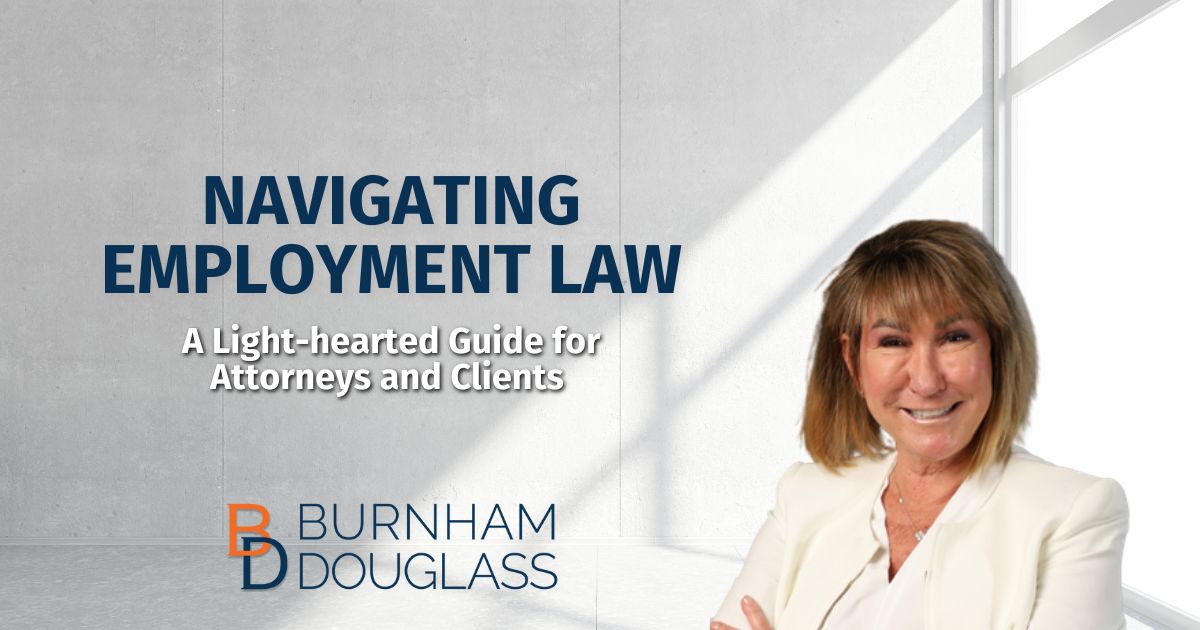Introduction:
Navigating the intricate landscape of employment law can be as tricky as trying to find the office coffee machine on a Monday morning. This guide aims to shed some light on the quirks and nuances, offering both attorneys and clients a roadmap for a smoother journey.
Selecting the Right Case:
Understanding the Basics
The area of law known as employment law includes every aspect of the employer-employee relationship. Workplace safety, wages, pensions, and unemployment compensation are all aspects of employment law. Various laws govern employment, and comprehending them is crucial before choosing a case.
Defining an Employee
Not everyone working for a business is an employee; some are independent contractors. The common-law test, as seen in Nationwide
Mutual Ins. Co. v. Darden considers factors like control, skill required, and the relationship’s duration.
The Top Ten Types of Employment Cases
Key principles derive from federal statutes and the Constitution, shaping cases related to discrimination, harassment, and more. Court interpretations and common law doctrines further influence these cases.
- Discrimination and Harassment:
- Discrimination and harassment based on race, gender, age, religion, disability, or other protected characteristics is illegal. Cases like McDonnell Douglas Corp. v. Green and Bostock v. Clayton County set standards for racial and LGBTQ+ discrimination, emphasizing the need for tangible evidence.
- Retaliation:
- Employers cannot retaliate against employees for exercising their legal rights, such as reporting discrimination or engaging in union activities. Title VII and most other anti-discrimination laws contain provisions that shield employees from retaliation for engaging in protected activities. These include filing a claim or making a charge of discrimination, as well as assisting or participating in an investigation of discrimination. Cases like
- Burlington Northern & Santa Fe Railway Co. v. White establish criteria for retaliatory actions.
- Also, many state laws and public policies safeguard whistleblowers who expose legal violations by their employers. Whistleblowing can be active, involving reporting the violation while continuing to work, or passive, entailing refusal to perform a task. Laws often protect both forms of whistleblowing. In Pierce v. Ortho Pharmaceutical Corp. employees can pursue wrongful discharge claims when terminated against a clear public policy mandate. Petermann v. Int’l Brotherhood of Teamsters establishes that an employer’s unrestricted right to discharge an employee can be denied if the reason is the employee’s refusal to commit perjury in an employment of unspecified duration.
- Wages and Hours:
- Compliance with minimum wage laws, overtime pay regulations, record-keeping requirements and understanding exemptions is essential. Cases like Bright v. Houston Northwest Medical Center Survivor, Inc. highlight considerations for compensable overtime.
- The First Amendment and Public Employees:
- Public employees’ constitutional freedom of speech rights are limited to matters of public concern, and the time, place, and manner of the speech may affect whether it is protected, as seen in Pickering v. Board of Education.
- Privacy Rights:
- Balancing workplace monitoring and privacy rights is complex, exemplified by cases such as O’Connor v. Ortega and Ontario v. Quon.
- Workplace Safety:
- Employers must provide a safe environment. The Occupational Safety and Health Act (OSH Act) standards are vital for ensuring workplace safety. OSHA does not create a private cause of action by an individual, as noted in Doe v. Scalia.
- Wrongful Termination and Employment Contracts:
- Employment in most states is at-will, but manuals or contracts can restrict termination grounds. Cases like Woolley v. Hoffmann-La Roche, Inc. establish expectations from employer manuals.
- Confidentiality and Non-Compete Agreements:
- Agreements protecting business interests must be reasonable. Cases like Devos, Ltd. v. United Returns, Inc. emphasize considerations for enforcing non-compete agreements.
- Employee Benefits
- ERISA regulates pension and welfare benefit plans. Cases like Williams v. Wright clarified the criteria for an ERISA plan and Bronk v. Mountain States Tel. & Tel., Inc. instructs that ERISA prohibits an employer from making distinctions based on age or length of service.
- Tort Claims Against Employers
- Tort damages post-termination may be limited but available. Cases like Hunter v. Up-Right, Inc. and Lewis v. Equitable Life Assurance Society discuss related claims.
Evaluating the Merit:
The Principle vs. Principal Conundrum
Clients often enter the legal arena with grand principles such as championing justice and righting wrongs. Their narrative may echo the heroic tales they’ve seen in movies or read about in inspiring legal dramas. While these principles are all well and good, even admirable, and provide the emotional fuel that propels them into action they must recognize the financial stage set behind the curtain.
Realistic Case Valuation. Money Matters.
In the legal theater, courts act as financial therapists, prescribing remedies that often translate into monetary compensation. Attorneys, like financial doctors, need to delve into the intricacies of calculating damages. This involves understanding formulas for special damages (directly measurable financial losses), general damages (non-economic losses like pain and suffering), and the elusive punitive damages (intended to punish the wrongdoer).
Example:
Consider a client who experienced wrongful termination. They may passionately assert the principle of standing up against injustice, but in legal terms, this translates to quantifiable losses. Lost wages, future earnings, and potential career advancements are tangible elements that contribute to the economic value of the case.
Economic Value vs. Emotional Satisfaction
While lost wages and financial losses are like digits in a calculator, emotions, such as pride and self-esteem, are intangible variables in the legal equation. It’s crucial for clients to recognize that courtrooms are not therapy sessions. The legal system focuses on tangible economic realities, often leaving emotional satisfaction at the courthouse steps.
Example:
Imagine a client who, after being wrongfully terminated, seeks emotional satisfaction through a prolonged legal battle. While their feelings of indignation are valid, the courtroom might not provide the emotional resolution they seek. Advising clients to channel their focus toward the economic aspects of the case helps in setting realistic expectations.
Million/ Multi-Million Dollar Settlements or Verdicts are the Exception, Not the Norm
Securing million and multi-million dollar settlements or verdicts is more of a legal feat worthy of headlines than an everyday occurrence. It’s crucial to understand that these substantial outcomes are anomalies rather than the standard. Exceptional lawyering, paired with extraordinary facts and an equally exceptional client, can pave the way for remarkable results, but such cases are far from typical. Success on this scale demands not only legal expertise but also a nuanced comprehension of the case’s intricacies.
The cases that do reach the million-dollar mark often involve sensational and highly egregious employer behavior, such as sexual assault, actions causing profound mental anguish resulting in permanent disability, or outrageous conduct like major cover-ups. Instances where a public figure misuses company funds or abuses their office, engaging in inappropriate conduct, can also lead to substantial settlements. Long and notorious patterns of illegal conduct, coupled with retaliatory actions against whistleblowers, are additional elements that may contribute to these extraordinary outcomes.
In whistleblower cases, where employees don’t necessarily have to prove an actual violation of the law but rather demonstrate a reasonable belief in lawbreaking and report it, the harsh reality is that juries often lean towards wanting tangible proof of the violation. This requires a delicate balance for the legal team to navigate, ensuring that the jury’s passion to punish the employer aligns with the nuances of the law.
Exceptional lawyering, paired with extraordinary facts and clients, leads to remarkable results. Sensational and egregious employer behavior, as in Saffos v. Avaya, Inc., can contribute to substantial outcomes.
Are Punitive Damages a Part of the Equation?
Valuing an employment case based on punitive damages is a delicate endeavor, given the rarity of employer conduct meeting the stringent legal elements required for such claims. Often, these claims face legal
motions from the employer, resulting in dismissals before they gain traction. While punitive damages can significantly enhance the overall value of employment cases, they aren’t universally applicable against employers. Crafting a litigation strategy that ensures the viability of a punitive damages claim is paramount, spanning from the initial complaint through discovery and trial.
Establishing punitive liability against an employer necessitates demonstrating malice, oppression, or fraud in specific scenarios. This includes situations where an employee’s misconduct was known and approved by the employer’s officers, directors, or managing agents.
Winning punitive damages in employment law cases, even in jurisdictions like New Jersey, poses challenges. Judges may dismiss such claims due to insufficient evidence, failure to prove malice or recklessness, limited employer liability for actions outside the scope of employment, or statutory limitations in certain jurisdictions. Notably, public entities are exempt from punitive damages claims.
Then There’s Mitigation of Damages
Plaintiffs have a duty to mitigate, yet success in finding new employment can reduce case value. Advising clients to secure new jobs may sting for the case’s bottom line, but it’s a dose of legal required reality in this quirky employment law carnival.
Setting Realistic Expectations:
Attorneys play a crucial role in helping clients set realistic expectations by providing legal guidance, managing communication, and educating them about the legal process. To make sure that realistic expectations are set from the beginning, start every client relationship by having a detailed and written engagement letter that outlines all the requisite details like; fees, scope of work, deadlines, etc. It is also very important to have an honest and open discussion about the possible outcomes and drawbacks of the client’s case during the initial client consultation. Educating clients about the legal process ensures transparency and trust.
Finally, while we all know this to be true, it doesn’t hurt to be reminded: communication and transparency with the client at all times is the golden rule. No news is good news doesn’t apply where legal matters are concerned.
Conclusion: The Legal Tango Continues:
As you waltz through the complexities of employment law, keep an eye out for the red flags that might disrupt the rhythm. Whether attorney or client, let the dance of legal navigation continue!

Michelle J. Douglass, Esq. is Of-Counsel to Burnham Douglass Law Group, is a Certified Civil Trial Attorney specializing in employment law related matters and may be reached at [email protected].


